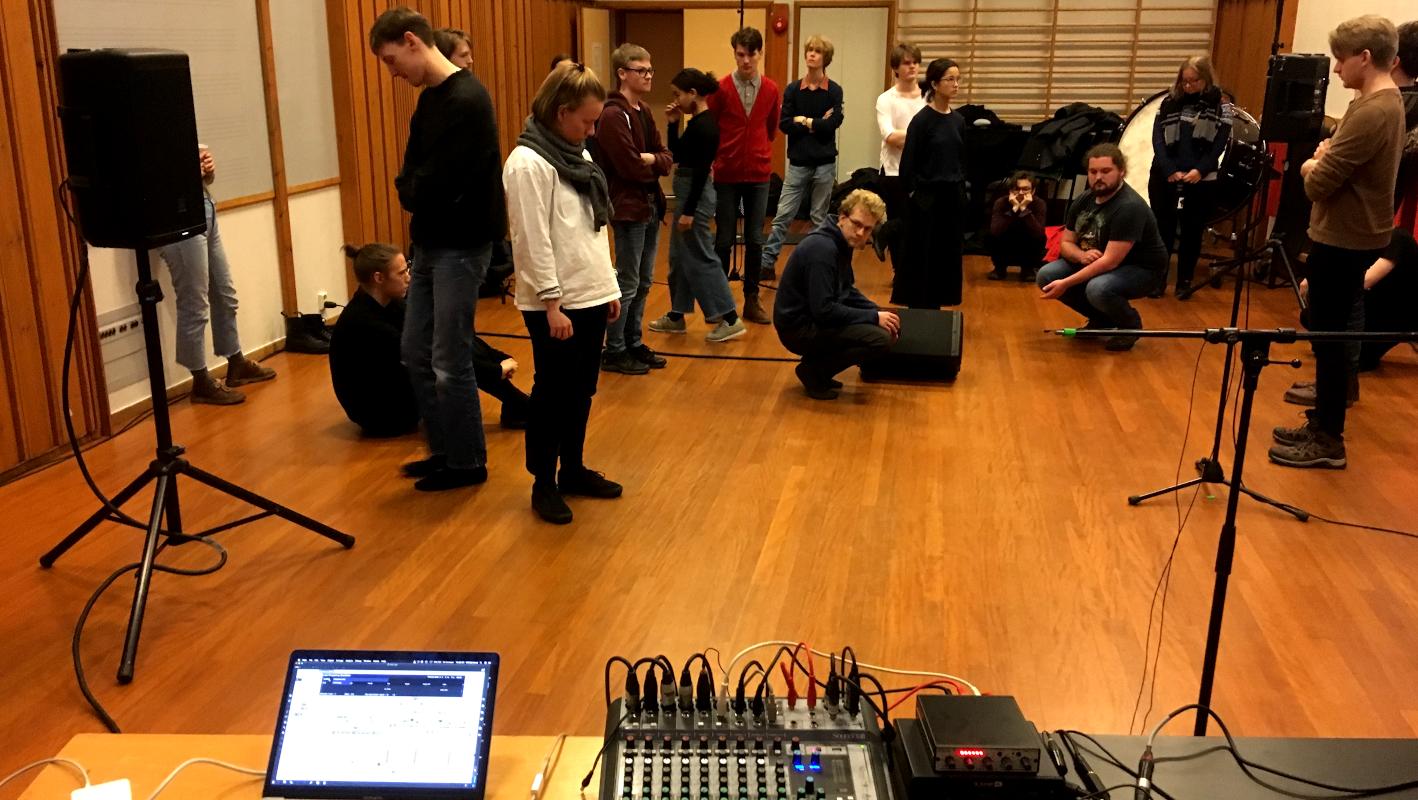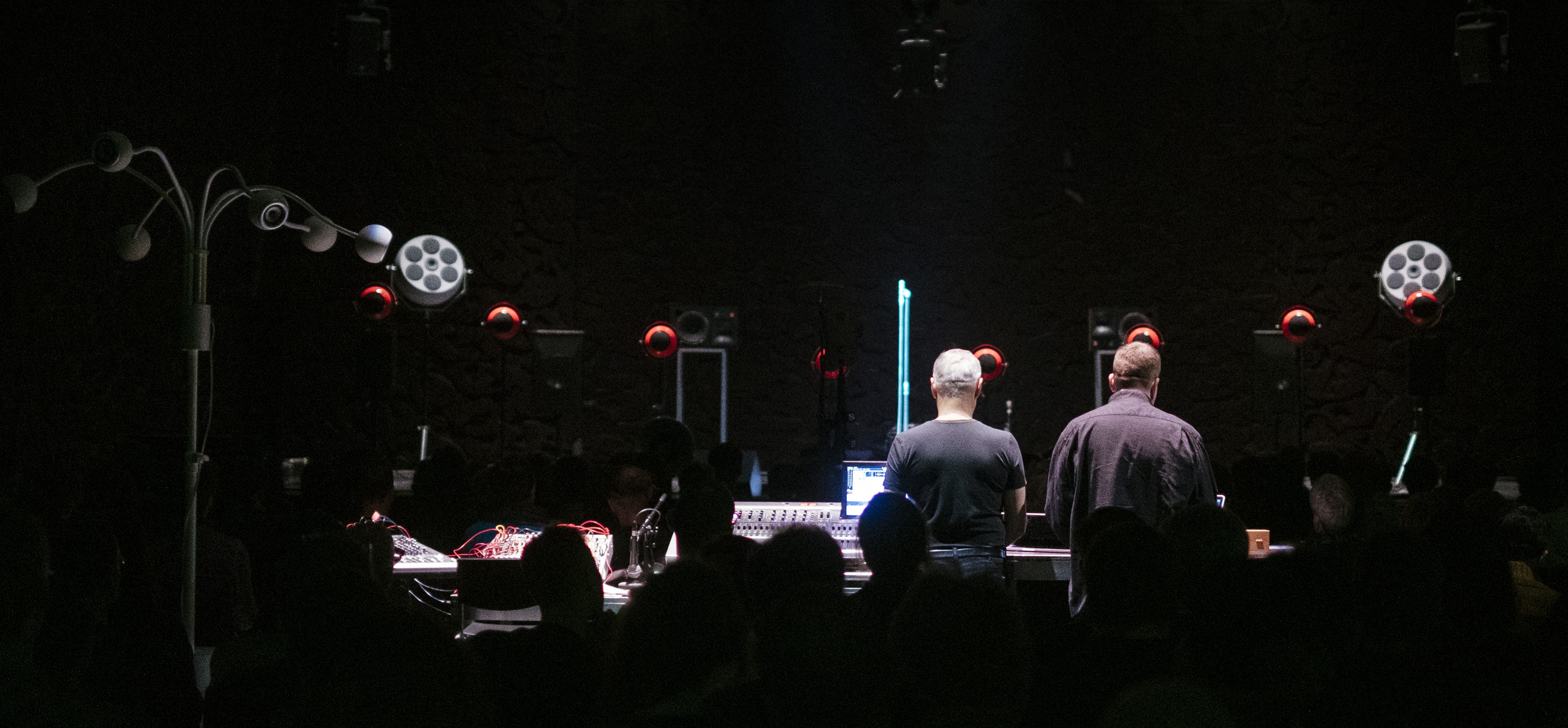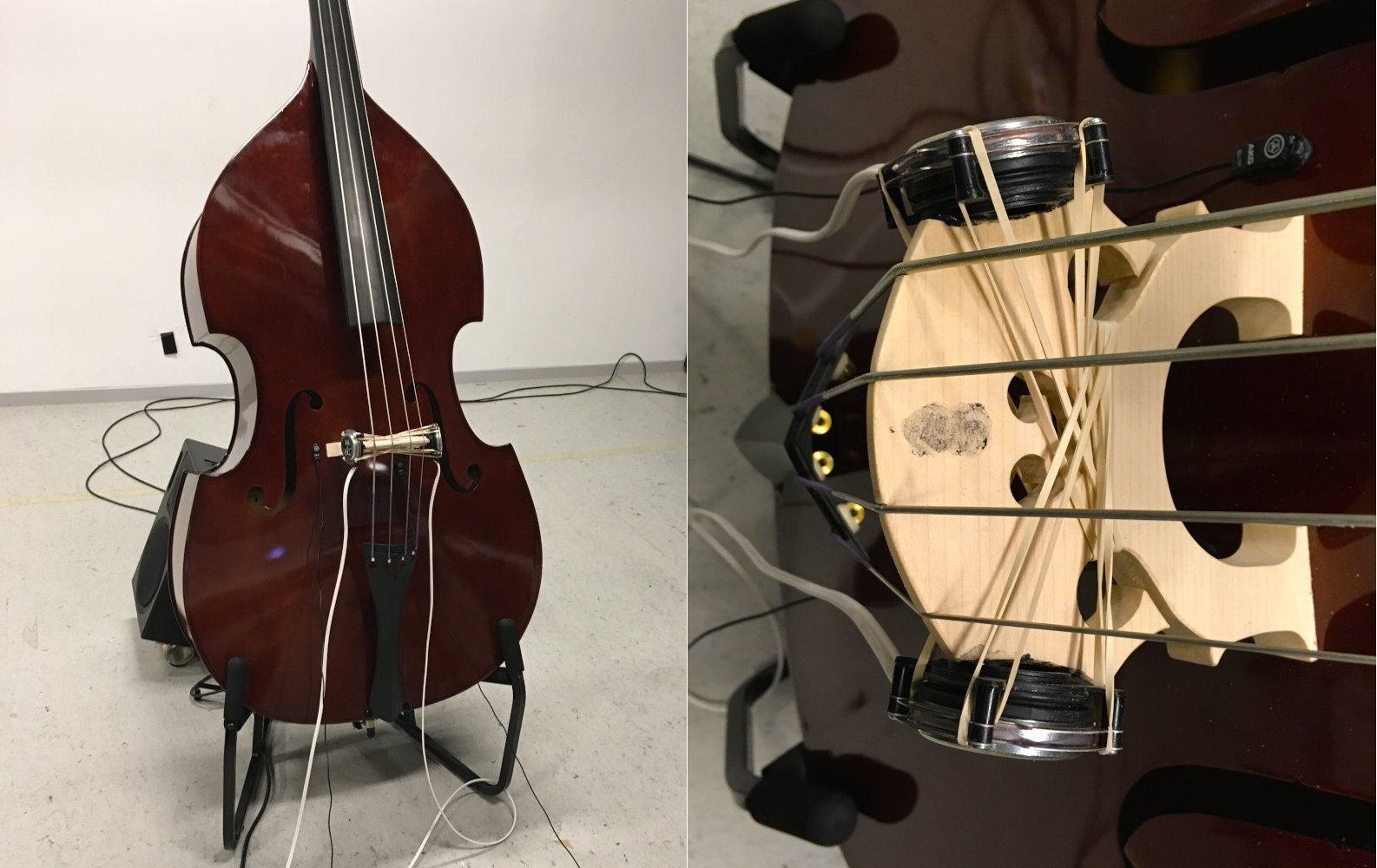Postdoctoral research
Ludvig Elblaus holds a two-year postdoctoral research position at NAVET that started in October 2019. He will present the results of that work on this page as it unfolds.

Introduction
The work done in this postdoc project is a continuation of a research collaboration with Gerhard Eckel that started in 2019, after I finished my PhD in Sound and Music Computing in 2018 where Eckel was one of my co-supervisors. The title of my thesis is Crafting Experience: Designing Digital Musical Instruments for Long-Term Use in Artistic Practice and takes the perspective of a digital luthier who realizes the artistic visions of others through collaborative processes of ideation, design and music making. In the work I have done since then, my own artistic production has been central, especially the collaborative musical work done together with Gerhard Eckel in the duo we have chosen to call utrumque.
Initial research direction
After a period of promising initial studio work using acoustic feedback where transducers, e.g. microphones and loudspeakers, where coupled with different prototypes of digital and analog sound processing, a direction of research into room scale acoustic feedback was established. The initial research questions were:
- Room scale acoustic feedback with audience and performers in the room presents a particular acoustic, technical and aesthetic situation. How does that manifest in the experience of performing, listening, or participating in some other way?
- What are the technical characteristics of such a musical material? How can it be created, manipulated, and composed with?
- If acoustic feedback can be tuned to make passive listening impossible by achieving equilibria that can be disturbed by the acoustic influence on the scale of a human body, what are the implications for the relationship between the composer and the listener, when the listener always also performs by their very presence?
- What then are the aesthetic and ethical concerns involved in composing for sound installations and site specific music?
- How can acoustic measurements help guide the composition process, and what tools and skills are needed to provide useful aids for composers when dealing with these sometimes very unpredictable dynamical systems?
Pandemic perspectives
As the postdoc started in late 2019, many of the activities set up for 2020 during the first months were of course cancelled because of the pandemic. Several workshops, concerts, seminars and other hands on activities involving close contact with collaborators and audiences had to be indefinitely postponed. This led to a shift in perspective that highlighted certain strands of the research, and while questions of more straight forward physical presence fell into the background, more subtle questions of other kinds of presence, experience, and aesthetic vantage points emerged. Especially the work connected to modelling as an artistic practice.
How can modelling, especially simulations of room acoustics, be used to approach site specific musical composition?
- Can a wider understanding of the modelling concept be useful to navigate the myriad of vantage points that erupt from contemporary staging of performed arts using streaming, remote presence and performance?
- What happens to the notion of site when neither performer nor audience are physically present in the space where a performance is staged? How is site disseminated in this multitude of perspectives and how does that relate to the many views and perspectives of a site formed in the compositional process that precedes the performance?
Research activities
Workshop and Seminar at the Norwegian Conservatory of Music
In november 2019, utrumque held a full day workshop on using feedback to create room scale acoustic instruments for students of the composition program at the Norwegian Academy of Music in Oslo. A smaller self selected group of students had an intensive course on techniques and compositional strategies, followed by compositional work and supervision in pairs. The second day, the results of the first day were presented by the students for their colleagues. This was followed by a student led seminar where the work was contextualised and critiqued from whithin the students' own practice. Finally, the students were invited to a concert by utrumque in the evening, using the same tools as the students had used in the workshop in the same space as the students had worked.

Rundgång - Performance at the Elevate Festival
Rundgång is an electroacoustic piece that was comissioned from utrumque for a concert with the GRM Acousmonium at the Elevate festival in 2020. In composing and performing Rundgång, many new valuable finds on the possible role of modelling in the production of site-specific music that became a large part of a paper presented at the Audio Mostly Conference later in 2020.
In the publication at Audio Mostly, we described the structure of the piece as follows: "The signal flow in the piece is simple: a microphone connects to a computer via an audio device, the computer processes the sound using the utruchord software, the sound is played on the Acousmonium speakers. Looking more closely at the software part, there are three layers of separate parallel signal processing chains that all take the microphone as their input and generate a mono output that is panned somewhere on the Acousmonium's many speakers. This means that in the resulting feedback, all sound is summed into one mono channel at the microphone. Each layer in the software contains a filter bank with a fixed number of bands (16, 8, and 32), filter slope (96, 48, and 96 dB per octave respectively), and varying transition frequencies and overlap throughout the piece.
The piece starts and stops with a staged intervention where a person steps into a spotlight on stage where a microphone is placed on a stand and completes the feedback loop by connecting the cable to the microphone. At the premiere, choreographer and dancer Alexander Gottfarb composed and performed this part. When the mic is plugged in, the piece is already playing through a score that animates some of the parameters in the software by interpolating between values placed on a timeline. The first layer moves slowly around the room using the outermost speakers, the second uses a set of speakers on stage and uses a higher register than the first, the third complements the smooth panning movement of the first two by jumping between speakers at an increasing rate, starting with six speakers in the middle and using speakers all over the hall towards the end of the piece. After a set number of repetitions of the jumping gesture, the microphone is unplugged, abruptly ending the piece that could otherwise have gone one indefinitely."

The piece was highlighted a review of the festival by Tristan Bath for The Quetus, who wrote: "A newly commissioned piece by utrumque – the duo of IEM-Professor Gerhard Eckel and KTH-Researcher Ludvig Elblaus – sees a microphone positioned alone on the stage while the pair man the Starship Enterprise control desk in the centre of the room, and guide a hanging feedback tone gently around the 3D space. It’s a red raw demonstration of the Acousmonium’s abilities, and as the tone shimmers and glitches into dizzying rhythms flying around our heads, an assistant leaps onto the empty stage, runs between the eyeball-like loudspeakers, and yanks the plug out from the microphone and brings the demonstration to a swift close."
Double Bass studio work
This work, undertaken by utrumque in the first months of 2020, involved transposing the room scale feedback work to another resonant body, the double bass. By utilizing several combinations of transducers, resonant feedback networks were constructed using combinations of mechanical vibrations in the body of the instrument and air vibrations in and around it. Placement and fastening of these transducers were not trivial and the resulting augmented instrument opened up a wide space of playing techniques. The resulting composition was to be performed in late March 2020, but was cancelled. A new work period for engaging with the bass is planned for the spring of 2021. This time, two basses will be augmented and connected over the internet, allowing for ensemble play online, allowing both for streamed concerts but also for new forms of networked performance practices that furter augments and extends the instrument. A fixed media piece will be produced and the work will continue with a commission to be premiered in Berlin in the summer of 2021.

Constellations - Online installation at NIME 2020
The International Conference on New Instruments for Musical Expression added an online installation track to adapt to the pandemic situation. Gerhard Eckel, Luc Döbereiner and I created an online installation called Constellations that was accepted to the conference and exhibited during the conference week. The following is a description from the program notes:
"Constellations is an emergent, self-organising, public global sound art piece. It is an online installation that connects the visitors and the involved electro-acoustic transducers, digital devices, places, and acoustic environments in a network that mutates with every visitor who joins or leaves it. The installation consists solely of its visitors. With only one visitor the installation is silent. By connecting and shaping the acoustic flow of energy, and by guiding it towards feedback, the system goes from being complex to being unpredictable.
The distributed model of the network and the localized forms of listening make it impossible to even attempt to control the experience for an individual connected visitor. Instead, the visitors are welcome to explore and shape the system’s behavior by becoming a sounding and listening node in the network, putting whatever they want in the feedback loop on their local end. Participants can choose to be quiet or actively contribute sounds to be dispersed in the network, but the act of connecting one’s acoustic space to the others is already a contribution that will affect everyone’s experience.
Constellations is both a subversion and a repurposing of web communication technology in order to create conditions for the indeterminate emergence of non-hierarchical structures."
The installation can still be accessed at utrumesh.net/constellations . Be aware that because of the nature of the installation described above, more than one person need to connect, prefferably several, to activate the installation in the intended way.
Clockwork - Hybrid presence performance and two paper presentations Audio Mostly 2020
Two full papers were accepted to and presented at the Audio Mostly Conference 2020. The theme of that conference edition was In Extended Realities, and reflected the many ways oen can interact with and through the audio modality and how activities and concerns that have been around periferally for many years now, because of the pandemic, have moved fron and center.
Furthermore, an utrumque piece, Clockwork, was premiered at Audio Mostly in one of the curated concerts that were a part of the conference. The piece is complex and involves the acoustic coupling of two physical spaces. In the paper, we describe the piece in the following way:
"In the piece, the two spaces are set up so that microphones in one can be played through loudspeakers in the other and vice versa. Furthermore, the spaces can be fed back into themselves, and all inputs and outputs are run through our custom signal processing software, utruchord. The utruchord software manages the selection and distribution of the connections, and the two physical rooms are simply connected via two cables providing a mono signal in each direction.
The piece creates pseudo-periodic musical gestures by panning a feedback loop in the CUBE depending on the amplitude of the signal produced by that very same loop. This works as a self limiting system since when the signal gets louder, it gets moved to a new position in the room, thus changing the phase relationship between the speaker and microphone membranes. In the feedback loop there is a filter bank with individual dynamical compression per band that makes it possible to create even further variation in what kind of patterns emerge from the amplitude controlled panning. The dynamical system in the CUBE is also fed the sounds from the staircase. Simultaneously, the sounds from the CUBE are also played in the staircase, making the resulting system highly complex and capable of great variation, while simultaneously being a result of the acoustic properties of the two spaces."
For more information on the paper, see the Publications section below. Below, you can stream a recording of the piece, as recorded at Audio Mostly. A longer fixed media version that uses recordings and further developments to the composition made after the festival is forthcoming.
Klangraum Performance
The online sound art gallery Klangraum, online at klangraum-dumpf.com , commissioned a piece by myself, Gerhard Eckel and Luc Döbereiner for the inauguration of their exhibition series in october 2020. Dumpf, the record label behind Klangraum describes it as "Music as a collective event requires a common place and time: KLANGRAUM is a platform for online sound works that explore the possibilities of remotely being together through sound. In its first iteration KLANGRAUM presents compositions, installations and live performances by Teresa Carrasco, Döbereiner/Eckel/Elblaus, Cathy van Eck, Davide Gagliardi, Ji Youn Kang, Veronika Klaus/Luk Poncet, David Pirrò, Casper Schipper, and Lara Stanic."
While the commissioned performance is no longer online, the rest of the program of interactive installations are running three times per day in one hour slots.
Publications
Acoustic modelling as a strategy for composing site-specific music
The International Conference on Audio Mostly, 2020
This paper describes two site-specific musical compositions, focusing on how modelling was used in their respective composition processes. Primarily, the acoustics of the sites were modelled to aid in the preparation and composition of the pieces. From this we propose the general use of modelling as a way to work with the concept of site. But the idea of formulating a model is also applicable more widely in the work described and this is discussed with the two pieces as starting points. Both pieces use acoustic room scale feedback as their only source of sound, so the impact of the room, speakers and microphones used is immense. The first piece, Rundgång, is a commission for the GRM Acousmonium. The second piece, Clockwork, is a public installationthat will also be the site of a performance, combining the installation with live interventions. Clockwork will also employ modelling as a component of the piece itself, and include a remote performerand a remote audience. We suggest that there are possibilities to employ compositional strategies to embrace these kinds of hybrid presence situations by composing for many vantage points.
utruchirp - An Impulse Response Measurement and Auralisation Tool Developed for Artistic Practice
The International Conference on Audio Mostly, 2020
This paper presents the utruchirp software, a tool for measuring impulse responses and modelling room acoustics in real time throughauralisation based on convolution using those responses. utruchirp is the result of concerns and needs emerging from the authors’ongoing artistic practice, exploring room scale acoustic feedback as material for live performance, installations, and fixed media pieces as utrumque. The paper provides the technical and, more importantly, the artistic details of the development of utruchirp and its features, highlighting those that are the direct result of insights from artistic work: Monitoring of all stages of measuring and signal processing, auralisations of the measurements from within the measurement process, and integrated round trip delay estimation. Finally, it points out future directions and features that are to be explored next,with an invitation for collaborative efforts, aiming to bring the sensibilities of musical instruments to our measurement tools.